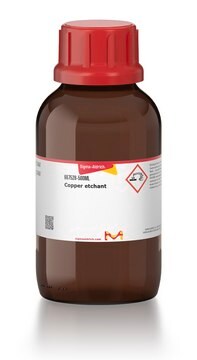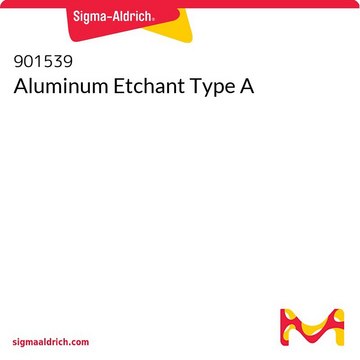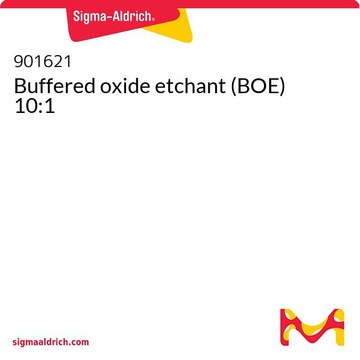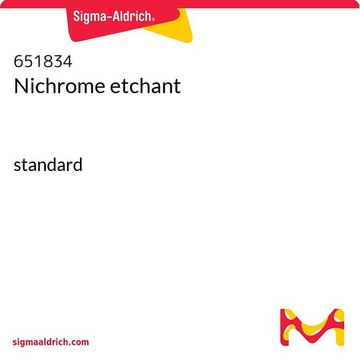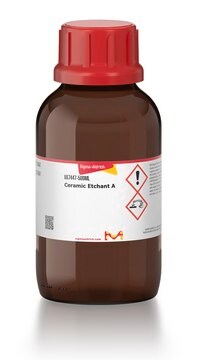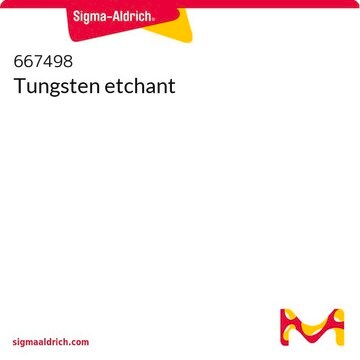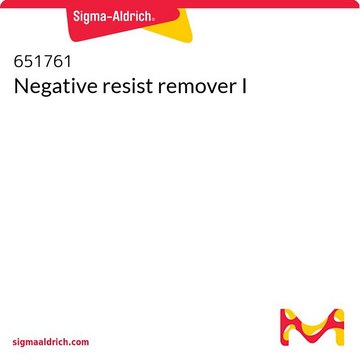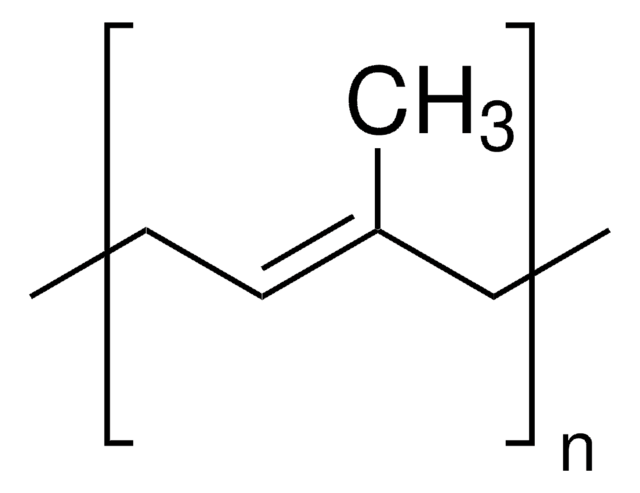651826
Chromium etchant
standard
Sinónimos:
Cr etching solution
Iniciar sesiónpara Ver la Fijación de precios por contrato y de la organización
About This Item
Productos recomendados
grade
standard
composition
volatiles, 85%
color
orange
bp
100 °C/1 atm
density
1.16 g/mL at 25 °C
General description
- Appearance - Clear orange
- pH - Acidic
- Etch Rate at 40 °C - 40 Å/second
- Etch Capacity (rate declines at ~70%) - 65 g/gallon
- Shelf Life - 1 year
- Storage Conditions - Ambient
- Filtration - 0.2 µm
- Recommended Operating Temperatures - 20-80 °C (30-40 °C most common)
- Rinse - Deionized water
- Photoresist Recommendations - KLT6000 Series, KLT 5300 Series, HARE SQT (SU-8 type), TRANSIST, or PKP -308PI
- Select Compatible Materials - Au, Ti, oxide, nitride, Si
- Select Incompatible Materials - Al, Ni, Cu, NiCr
- Compatible Plastics - HDPE, PP, PTFE, PFA, PVC
- Isotropy - Isotropic
- Incompatible Chemicals - Strong bases
Ceric ammonium nitrate-based etchant. Etch rate of 40 Å/sec @ room temp. Etches cleanly with only a deionized water rinse needed.
Chromium etchant is a chromium based solution that removes the excess metal from the substrate. These etchants are majorly used in metal finishing and electronic industry. It has an etch rate of 4 mm/s and can be used to etch nickel, copper, and chromium based excess metals.
Our chromium etchant is high purity ceric ammonium nitrate system for precise, clean etching of chromium and chromium oxide films. Compatible with positive and negative photoresists. Our chromium etchant is filtered to remove all particulates above 0.2 microns. Etching temperature varies depending on film thickness. Etch times range from 15 seconds to 60 seconds at room temperature. Chromium Etchants should be operated in a well-ventilated hood.
Application
For use at room temperature or elevated temperature. Etches cleanly, eliminating need for an intermediate rinse. Etching temperature varies with regard to film thickness. Etch times range from 15 to 60 seconds at room temperature. Note, chromium etchants should be handled in a well ventilated hood.
The product can etch Al, Cr, Cu, Ni, GaAs. It can surface oxidize Si, Ta/TaN, however, it has no effect on Au, Si3N4, SiO2, Ti, and W surfaces
Features and Benefits
Designed for precise, clean etching of chromium and chromium oxide films. Compatible with both positive and negative photoresists. Filtered to 0.2 micron to remove particlulates.
signalword
Danger
hcodes
Hazard Classifications
Aquatic Chronic 2 - Eye Dam. 1 - Met. Corr. 1 - Ox. Liq. 2 - Skin Corr. 1B - Skin Sens. 1
supp_hazards
Storage Class
5.1B - Oxidizing hazardous materials
wgk_germany
WGK 3
flash_point_f
Not applicable
flash_point_c
Not applicable
Elija entre una de las versiones más recientes:
¿Ya tiene este producto?
Encuentre la documentación para los productos que ha comprado recientemente en la Biblioteca de documentos.
Los clientes también vieron
Reconstituting Functional Microtubule-Barrier Interactions.
Methods in Cell Biology, 120(5), 69-90 (2014)
Fabrication and Mechanical Properties Measurements of 3D Microtissues for the Study of Cell-Matrix Interactions.
The Surfaceome, 120(5), 303-328 (2018)
The regeneration and recycle of chromium etching solutions using concentrator cell membrane technology.
Chaudhary AJ, et al.
Chemosphere, 62(5), 841-846 (2006)
Pressure-driven Fermi surface reconstruction of chromium
Stillwell RL, et al.
Physical Review, 88(12) (2013)
F J Alfaro-Mozaz et al.
Nature communications, 8, 15624-15624 (2017-06-08)
Polaritons in layered materials-including van der Waals materials-exhibit hyperbolic dispersion and strong field confinement, which makes them highly attractive for applications including optical nanofocusing, sensing and control of spontaneous emission. Here we report a near-field study of polaritonic Fabry-Perot resonances
Nuestro equipo de científicos tiene experiencia en todas las áreas de investigación: Ciencias de la vida, Ciencia de los materiales, Síntesis química, Cromatografía, Analítica y muchas otras.
Póngase en contacto con el Servicio técnico
